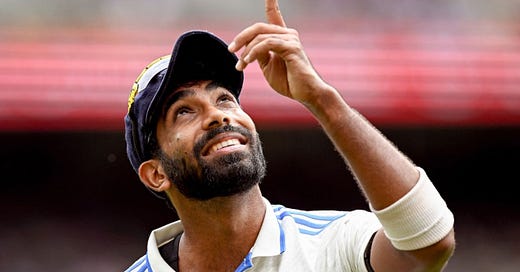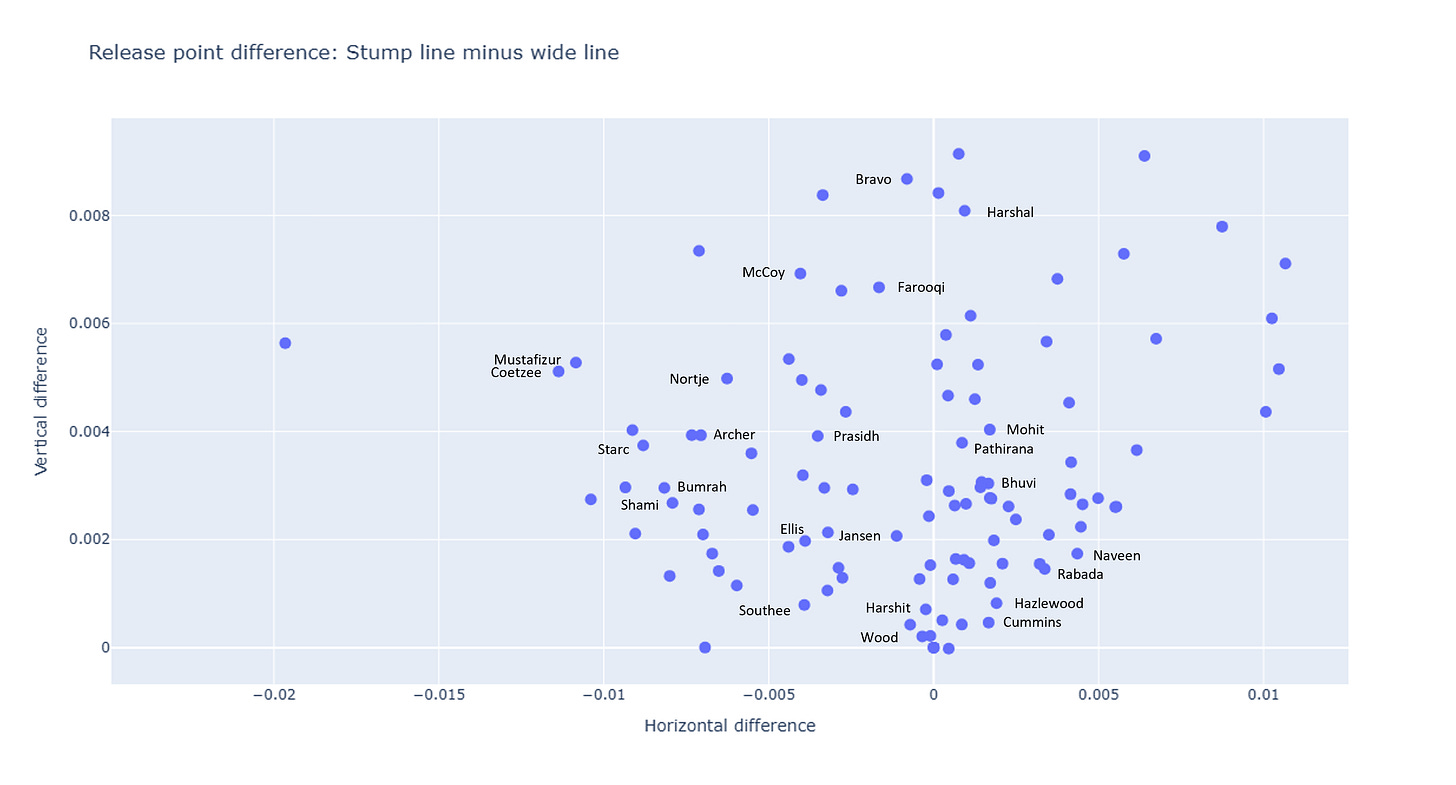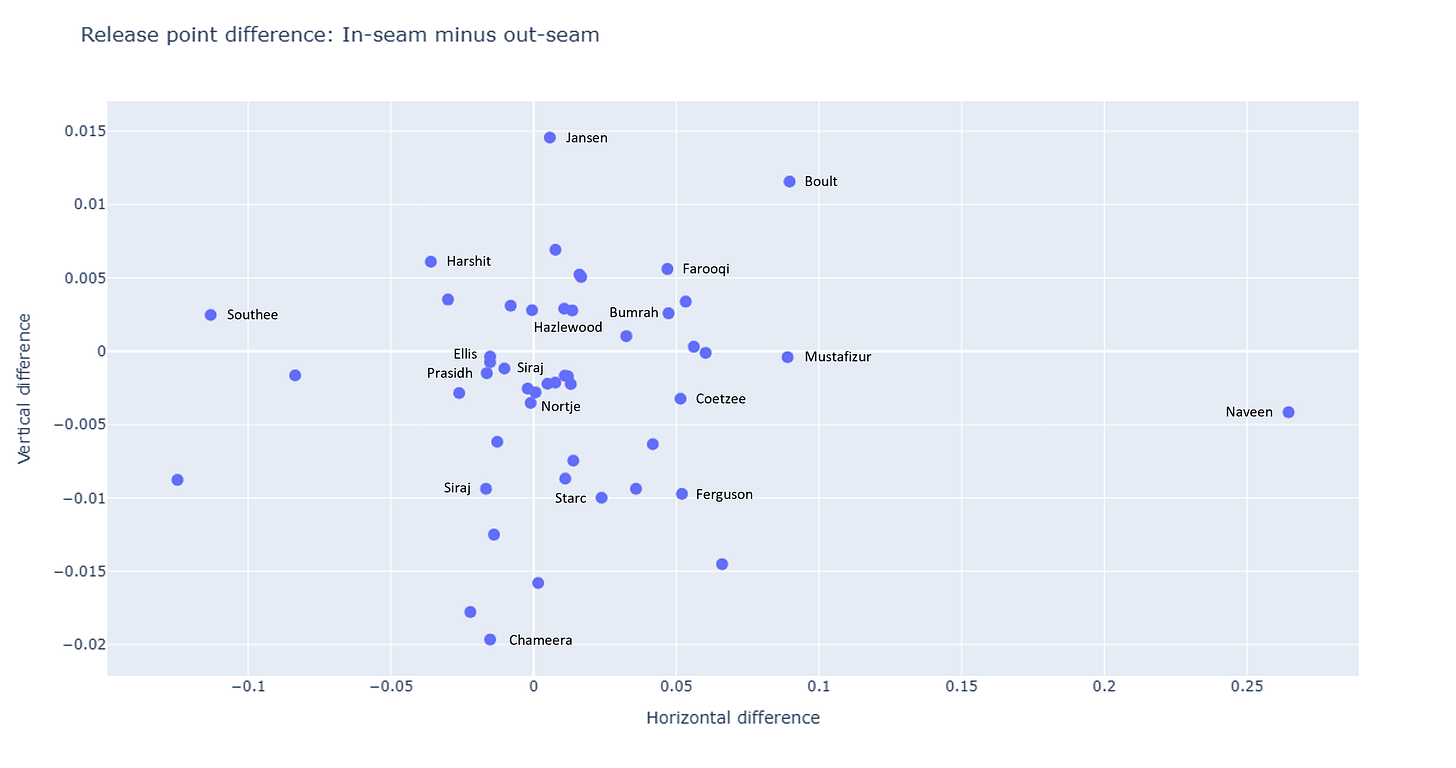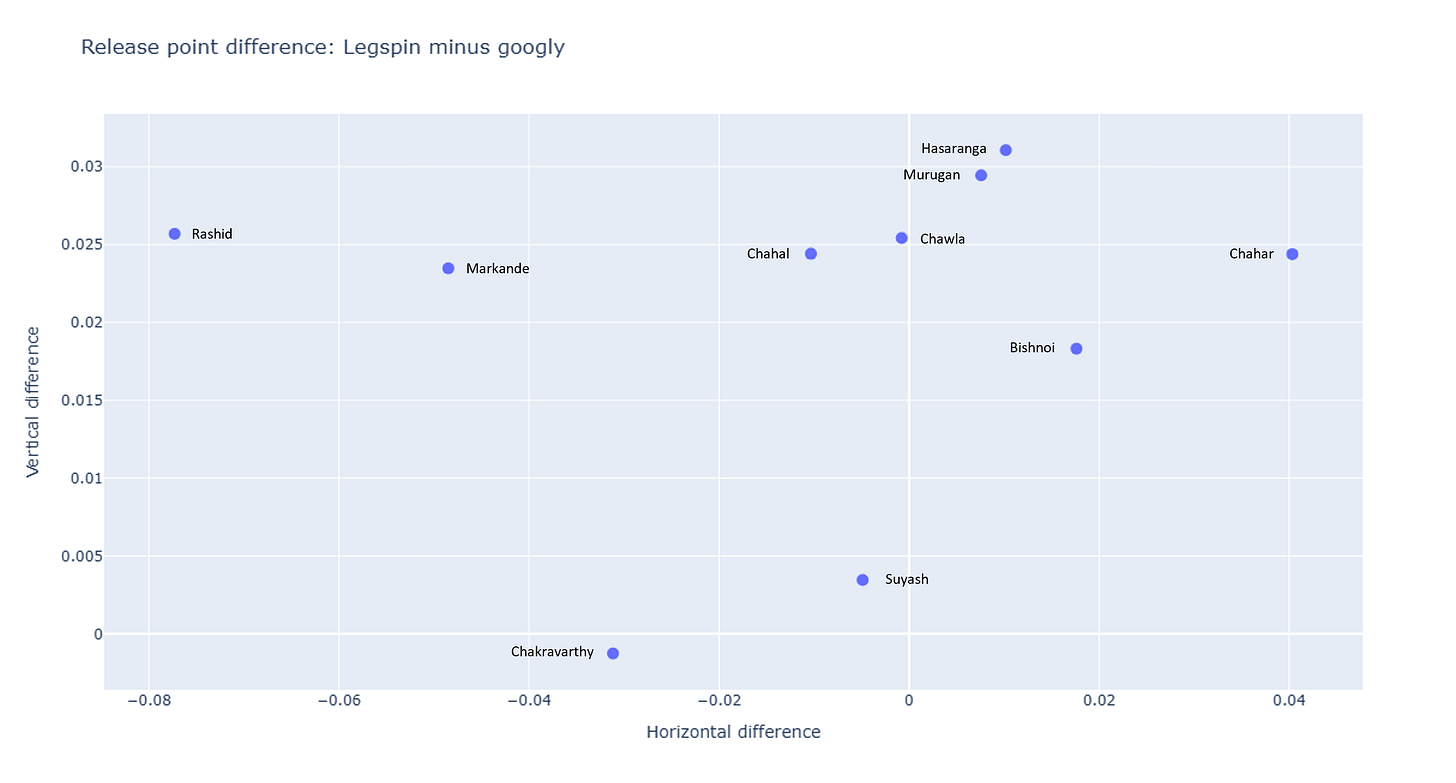Clues from the crease
Can ball-tracking data be leveraged to point out bowlers who give away the fewest pre-delivery cues?
Two years ago, I reviewed the academic literature on how elite batters synthesize pre-delivery cues to predict the features of a ball even before it is bowled. An archived version of this article can be found here.
The story was as follows. Human reflexes take in the range of 500 to 700 milliseconds, but elite batters in high-speed interception sports, such as cricket and baseball, receive much less time to perceive and react to a delivery. It follows that elite practitioners of these sports are efficient at harnessing “pre-release cues” to predict the features of the ball, even before it is bowled. For example, Tim Southee’s non-bowling hand used to point straight when he bowled outswing, and towards fine-leg when he scrambled the seam. Decades of batting under the sun have enabled elite batters to subconsciously gauge and process such cues.
Virtually all of the evidence for this thesis comes from controlled environments, where researchers can study athletes away from the complexities of the cricket field. Could it be possible, though, to pinpoint bowlers who “tip their pitches” from in-match data?
The most granular data we have available in cricket currently is Hawkeye’s ball-tracking data, which gives the three-dimensional co-ordinates of the ball from the moment it is released to the instant when it is intercepted at the crease. But pre-delivery cues are, definitionally, those which are exuded before and during release, so there isn’t much in this data that will answer our question. However, there exists a small intersection between what we need and what we have in the data that could aid us in this project.
A few months ago, a friend of mine used data on the release point of fast bowlers to come up with the extraordinary insight that one way in which Jasprit Bumrah differs from his contemporary fast bowlers is in that he is able to change his lengths without tweaking his release point - a seemingly superhuman skill because the way to shorten length is to delay ball release - which you will find quoted in this ESPNcricinfo article.
In the same vein, using ball-tracking data from the last three IPL seasons shared by my friend and former Team India analyst Himanish Ganjoo, I attempted to rank bowlers by the extent to which they tip their cards before the ball is bowled. A limited analysis, no doubt, because it relies on an incomplete measure of pre-release cues, but one I think is novel because it hasn't been attempted before to the best of my knowledge.
Most of my analysis was focused on fast bowlers, since it is when the speed of bowling is quick that the ability to synthesize pre-release cues attains significance. To this end, I look at five different features. The most sensible one is length, because as I said the way to shorten length is by holding on to the ball for a bit longer. A similar argument can be made about line, but I think sideways wrist movement is more controllable than up-and-down wrist movement, so bowlers can also change their lines using their wrists, without changing their release points. I also look at the type of swing and the type of seam - maybe some bowlers release the ball from wider of the crease when they bowl inswing - and, finally, at slower balls.
A note on how to read the plots that follow. Suppose the title of the plot is "Release point difference: A minus B". On the x axis is given the difference in release points along the horizontal plane when the bowler attempts two different delivery types. This figure being more positive means that the bowler has gone closer to the stumps when he bowls ball type A than he does when he bowls ball type B. Analogously, on the y axis is given the difference in release points on the vertical plane. This figure being more positive means that the bowler releases the ball from a taller height when he bowls ball type A than when he does ball type B.
Ideally, one wants to see a concentration of bowlers around the origin, for this would imply that the bowler releases both ball types from the same point so he does not give away any pre-delivery cues. In other words: these are the bowlers who "seem" faster than the speed gun says they do.1
Length
Firstly, notice that the range for the plotted quantities (which are in meters) is next to miniscule. This is all the information players have available when predicting the features of a ball. That elite batters are still able to perform this task with accuracy is the kind of thing that makes sport full of marvel.
Now to make specific inferences from the plot. As expected, the difference in release height when going from full to short is always positive, confirming the intuition that it is by letting go of the ball at a later point in the stride that a bowler shortens length. But which bowlers shift between lengths with minimal difference in release height? At the top of this list are Prasidh Krishna, Andre Russell and Jasprit Bumrah. Perhaps these men have wrist snaps so flexible and powerful that they can direct the ball towards a shorter pitching point without varying the release.
It's also interesting that Lockie Ferguson and Naveen-ul-Haq, two bowlers other than Bumrah to have prominent 11-o-clock release angles, are clustered next to one another. Could it be the case that such bowlers experience an advantage when it comes to concealing pre-release cues?
There's a concentration of left-arm seamers towards the top right of the plot - in Trent Boult, Fazalhaq Farooqi, Mustafizur Rahman, Obed McCoy, Mohsin Khan, Marco Jansen and T Natarajan - which means these bowlers not only delay their circumduction when bowling short but also go wide of the crease. One way of interpreting this is that the novelty of left-handed seamers makes it difficult already for batters to glean pre-release cues off them, so at higher levels there isn't a selection of southpaw pacers who cover their tracks going on.
Lastly, it's worth noting that the Indian trio of Mohammad Shami, Arshdeep Singh and Shardul Thakur are top of the list when it comes to changing lengths with the least alteration in horizontal release points.
Line, Swing, Seam
The range of these plotted quantities being so low, especially for change in line, suggests that release point differences are not significant enough for batters to derive any meaningful information pertaining to these features. So I will simply go over some general inferences.
Firstly, notice how Bumrah sits right next to the origin in almost all four plots. As several batters have reported, he is able to send down different ball types with minimal change in action. This is the part of his genius that is not explained by his genetic anomalousless. Another name that keeps popping up around the middle of these plots is that of Harshit Rana — a big reason to get excited about the 6'3 Indian pacer. Finally, it's worth noting that there is a set of bowlers who consistently come out at the periphery of all four plots - cue Jansen, Naveen-ul-Haq and Dushmantha Chameera - which not only tells us a thing or two about these bowlers, but also informs us that these signals are probably meaningful.
Slower balls
Driven possibly by the fact that the cutter is a brand of slower ball most pacers pick up early on in their professional careers, there seems to be a concentration of bowlers who predominately bowl the off-cutter as their primary slower ball next to the origin (the key exception being Jaydev Unadkat). Some of the great slower-ball bowlers lie in this zone: Dwayne Bravo, Harshal Patel, Nathan Ellis, Rana.
Obed McCoy, who had been identified around 2021-22 as someone who bowls his back-of-the-hand slower ball from a more upright angle, exudes multiple pre-release cues, including going 12cm wide of the crease to bowl his slower one. The trio of Avesh Khan, Deepak Chahar and Arshdeep Singh (who began developing a back-of-the-hand version this year) are at the far left.
Spin
A conceptual problem arises when performing this analysis for spin bowlers. Because they bowl at slower speeds, the importance of pre-release cues diminishes. But there is one feature that is anecdotally known to be deciphered from the hand - variation - especially against wristspinners. So it makes some sense to plot the average release point differences of bowlers who have the googly as well as the stock legspinner.
Of the ten bowlers who are marked as having bowled 30 or more of both these varieties in the last three IPLs, it's a surprising candidate who sits at the smallest distance away from the origin: Suyash Sharma. Rashid Khan tends to bowl his googly from a bit wider of the crease, while Varun Chakravarthy is also able to conceal his change-up rather well.
Keep in mind that there is probably some confounding by length going on here - it's possible that many leggies float their googly up - so take this with a pinch of salt.
I’ve checked, and these rankings correlate only weakly with the overall efficacy of these bowlers. But this is a comment on the insufficient granularity of the data we have available in cricket at the moment, and further, the complexity of cricket. The full extent of what pre-release exactly cues compose is something we are yet to uncover, and in-match ball-tracking data maps it only sparsely anyway.
However, such an investigation the only way we can systematically pinpoint such players outside of controlled environments, because the mastery of elite bowlers is so fine that it is invisible to the naked eye. And doing so is important because it is unlikely we can get a Bumrah into the lab. This article advances a framework for this task, and in doing so, I believe it is useful.
Above all, these rankings shed light on the nature of the margins at play in international cricket. Batters have minimum information to depend on, yet they are good at processing such information, so we have bowlers who have evolved to be good at concealing this information. Elite athletes are supernatural entities beyond our comprehension. Perhaps in the near future, the full extent of their extraordinariness can be uncovered using in-match biomechanical data.
Some general technical notes: Only bowlers who have bowled a minimum of 30 deliveries each of both ball types are included. All release points from the right side of the crease have been flipped for consistency. For the analysis of swing and seam, only the first six overs of a T20 innings are considered.











Very interesting analysis, but I wonder how useful these pre-release cues are in reality.
They would be very easy for the bowler to fake — just bowl the occasional away swinger from wide on the crease (aim at leg stump, swing to hit off), and the batter’s pre-meditation fails.
fwiw — my _feeling_ is that batters gain more information from the very moment of release, from the seam orientation and hand position behind/beside the ball, characteristics that can’t be faked.
Perhaps…